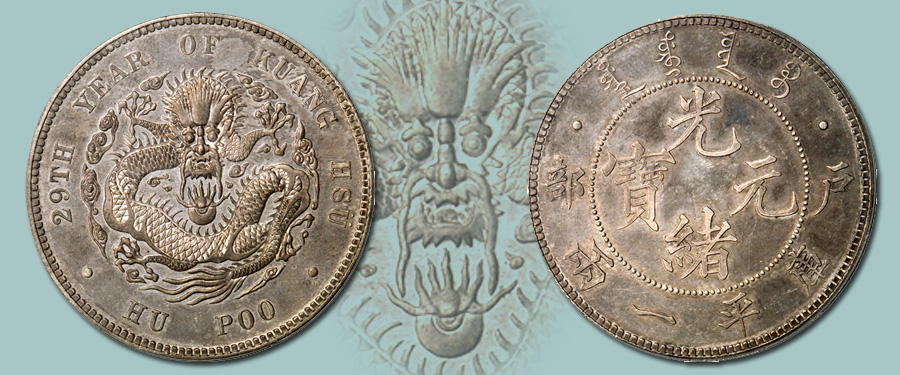
Today’s highlight is a true showstopper: a piece of the utmost rarity and prestige, the Hu Poo Specimen Pattern Tael. Coinage reform in China was slow and tumultuous, and this coin represents the largest denomination from one of the first series of proposed coinage reform. At the time of this coin’s striking in 1903 China’s last Qing Dynasty emperor – Kuang Hsu – and his government were unsuccessfully attempting to reform China’s coinage system. More than a decade had passed since Kwangtung Province had begun minting its “7 Mace & 2 Candareens” silver dollar, and in that decade other provincial viceroys had lined their pockets (and garnered excessive power) by minting their own local coinage. This would grow into one of the most chaotic monetary systems in the world, and the Imperial government was fully aware of the corrupt and inconsistent scheme. Unfortunately the central government lacked the competency to create a lasting reform that could supplant the local provincial governors’ various mintages. However, the excessive provincial issues and various unified currency reform series would later be a great boon for collectors, as it provided a diverse range of collectible material.
The obverse features the iconic dragon emblem synonymous with China, shown in mid-flight in a fierce side-winding pose. From the bottom the dragon’s long serpentine body starts with eight vicious tail-spikes, coils abruptly to the left, then wraps back to the right, and then gathers up toward the top behind the head of the dragon. Four arms and claws jut out from the body, and the entire body is adorned with rounded overlapping scales. A row of spines designates the dragon’s spine, culminating with a crown of barbs and ridges at the dragon’s head. Whiskers from the dragon’s face draw the eye toward a flaming pearl issuing from the dragon’s mouth. Elegantly swirled cloud designs encircle the dragon, and delicate vaporous tendrils cling to the dragon’s body, evoking an ethereal aura to this impressive coin’s visual appeal. The outer English legend: “29th Year of Kuang Hsu” and “Hu Poo” are divided by single dots on either side, and they provide the date (1903) and locale — Hu Poo refers to the Board of Revenue in Peking. This location was to serve as the central mint, effectively producing silver coinage for the entire country to assure its uniformity.
The reverse provides an exclusively Chinese and Manchu legend. Within a beaded circle four Chinese symbols denote: “Valuable Coin (of the) Kuang Hsu (regime).” Four Manchu characters appear above the outer ring and convey the same meaning as the central inscription. Two singular dots separate the Manchu and Chinese legends, and the two symbols at the exact right and left signify “Hu-Poo” or Board of Revenue as the location of minting. The four Chinese characters at the bottom represent the denomination: “1 K’uping Tael.” This coin is tied for finest graded by PCGS or NGC, at Specimen 63. The extremely limited numbers of these patterns were never destined for circulation, partially because the scheme of Chinese coinage reform (at that point in time) was doomed before it started. As such, these coins are exceedingly rare, and this impressive piece will certainly be the centerpiece of its new collection.
This coin represents the largest denomination (one Tael) of the attempted first unified machine struck series. In the aftermath of the Boxer Rebellion of 1900-01 and the Mackay Treaty, Great Britain pressured China to agree to create a unified coinage system. To enact this restructuring, the esteemed Sir Robert Hart, Inspector General of the Maritime Customs, set forth a proposed uniform national silver coinage. One key to Mr. Hart’s coinage reform was basing the system on a gold standard. He proposed a system with four values; 1 Tael, ½ Tael, ¼ Tael, and 1/10 Tael (1 Mace). However, when the Chinese officials sent their order to the Osaka Mint in Japan to create the master dies, five denominations were specified; 1 Tael, 5, 2, 1 and ½ Mace. After the Osaka Mint created the original dies, they were sent to the Tientsin Mint to be struck in proof or specimen quality.
Despite the simple elegance of this coin, Hart’s plot to oust the provincial viceroy’s control over the coinage system of his adopted country ultimately failed. The local and foreign influences that stood to lose the most from the centralized monetary system blocked the reforms from taking place. Another roadblock was the vast number and types of paper money in circulation, including the items issued by foreign holdings within China proper (the British colony of Hong Kong and the Portuguese colony of Macau are but a few). Hart and the Qing emperor and government that hired him were ultimately unable to wrest control of the coinage system from the provincial leaders and foreign influences. However, numismatic enthusiasts should be thankful as their attempts led to this wonderful specimen. This silver dollar sized coin is of the utmost rarity and is certainly a treasured feature of our upcoming auction.
Look for this and other Asian and world numismatic rarities in our upcoming April Hong Kong Showcase Auction and Sale. Preview this impressive coin along with the rest of our auction this March at the Stack’s Bowers and Ponterio office located in Irvine, California. For details please refer to the Events Calendar link at StacksBowers.com. To schedule an appointment, please call 800.458.4646. While our Stack’s Bowers Galleries April Hong Kong Showcase Auction is no longer open for consignments, we are taking consignments of ancient and world coins for our August 2015 ANA World’s Fair of Money Showcase Auction and Asian coins and currency for our August 2015 Hong Kong Showcase Auction. If you are interested in consigning your coins and paper currency (whether a whole collection or a single rarity) be sure to contact one of our consignment directors.





